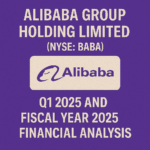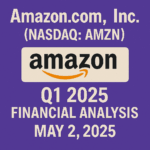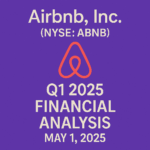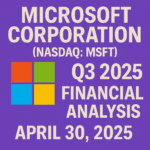Walmart Inc. (NYSE: WMT)
Q1 2025 Financial Analysis | May 15, 2025
Executive Summary
Walmart reported solid Q1 2025 results with steady growth in revenue and operating income. Total revenue increased 2.5% to $165.6 billion (4.0% in constant currency), while operating income grew 4.3% to $7.1 billion. The company demonstrated particular strength in eCommerce, which grew 22% globally, and its global advertising business, which increased by 50%. Walmart U.S. comp sales grew 4.5% with strong performance in health & wellness and grocery categories. The company maintained its outlook for fiscal year 2026 while issuing Q2 guidance for net sales growth of 3.5% to 4.5% in constant currency.
Q1 2025 Highlights
Financial Performance
Walmart delivered revenue of $165.6 billion in Q1 2025, representing a 2.5% increase from the prior year period. On a constant currency basis, revenue increased 4.0%, despite facing an approximately 100 basis point headwind from lapping the previous year's leap day. The revenue growth was primarily driven by strong comp sales in Walmart U.S. and Sam's Club, along with significant growth in the company's eCommerce and advertising businesses.
Operating income increased 4.3% to $7.1 billion, or 3.0% in constant currency when adjusted. This growth was achieved despite approximately 250 basis points of headwind from lapping leap day. The company's operating income benefited from higher gross margins, growth in membership income, and improved economics in eCommerce operations. The gross margin rate expanded 12 basis points, led by improvements in the Walmart U.S. segment.
Net income decreased to $4.5 billion compared to $5.1 billion in the prior year period, representing a 12.1% decline. This decrease was primarily due to a net loss on equity and other investments. When excluding this effect, adjusted earnings per share was $0.61, a slight increase from $0.60 in the prior year. The company's return on assets (ROA) was 7.5%, while return on investment (ROI) increased 30 basis points to 15.3%.
Global eCommerce sales grew 22%, led by store-fulfilled pickup & delivery services and marketplace offerings. Digital mix increased across all segments, with eCommerce contributing approximately 350 basis points to Walmart U.S. comp sales growth. The company's global advertising business grew by an impressive 50%, including the contribution from the recently acquired VIZIO. Excluding VIZIO, Walmart Connect in the U.S. increased 31%.
Free cash flow for the quarter was $0.4 billion, representing a $0.9 billion increase from the prior year period. This improvement was primarily driven by a $1.2 billion increase in operating cash flow to $5.4 billion, partially offset by increased capital expenditures to support the company's investment strategy. Walmart maintained a strong liquidity position with $9.3 billion in cash and cash equivalents at the end of the quarter.
Segment Performance
| Segment | Net Sales ($B) | YoY Change | Comp Sales | Operating Income ($B) | YoY Change |
|---|---|---|---|---|---|
| Walmart U.S. | $112.2 | +3.2% | +4.5% | $5.7 | +7.0% |
| Walmart International | $29.8 | -0.3% (+7.8% cc) | N/A | $1.3 | -17.5% (-6.4% cc) |
| Sam's Club U.S. | $22.1 | +2.9% (+5.5% ex-fuel) | +6.7% (ex-fuel) | $0.7 | +11.5% |
Walmart U.S. delivered net sales of $112.2 billion, a 3.2% increase from the prior year period. Comparable sales grew 4.5% excluding fuel, with transaction count rising 1.6% and average ticket increasing 2.8%. Growth was led by health & wellness and grocery categories, with the company continuing to gain grocery market share. eCommerce sales increased 21%, contributing approximately 350 basis points to comparable sales growth. This growth reflected strength in store-fulfilled pickup & delivery services, advertising, and marketplace. Operating income grew 7.0% to $5.7 billion, benefiting from a 25 basis point expansion in gross profit rate, double-digit growth in membership income, and improved eCommerce economics.
Walmart International reported net sales of $29.8 billion, a slight decrease of 0.3% from the prior year period. However, on a constant currency basis, net sales grew 7.8%, led by strong performance in China, Flipkart, and Walmex. The segment saw growth in both transaction counts and unit volumes, with particular strength in general merchandise and continued momentum in food and consumables. eCommerce sales increased 20%, led by store-fulfilled pickup & delivery and marketplace offerings. Operating income decreased 17.5% (6.4% in constant currency) to $1.3 billion, primarily due to strategic growth investments for Flipkart, Walmex, and Canada. Currency rate fluctuations negatively affected sales by $2.4 billion and operating income by $0.2 billion.
Sam's Club U.S. delivered net sales of $22.1 billion, a 2.9% increase from the prior year period. Excluding fuel, net sales grew 5.5%. Comparable sales increased 6.7% excluding fuel, driven by a 4.8% increase in transactions and a 1.7% increase in average ticket. Sales growth was led by grocery and health & wellness categories, with the segment experiencing its fourth consecutive quarter of positive general merchandise sales. eCommerce sales grew 27%, including delivery growth of approximately 160%. Membership income increased 9.6%, with steady growth in member counts, renewal rates, and Plus members. Operating income grew 11.5% to $0.7 billion, driven by continued momentum throughout the business.
Overall, the segment performance reflected Walmart's ability to drive growth across all its business units despite a challenging comparison to the prior year period, which included leap day. The company's strategic investments in eCommerce, marketplace capabilities, and store-fulfilled delivery services continued to yield positive results, particularly in the Walmart U.S. and Sam's Club segments.
Digital and Omnichannel Growth
Walmart's Q1 2025 results highlighted the company's continued success in advancing its digital and omnichannel capabilities:
eCommerce Performance
- Global Growth: eCommerce sales increased 22% globally, with strong performance across all segments
- Walmart U.S.: eCommerce sales grew 21%, contributing approximately 350 basis points to comparable sales growth
- Sam's Club: eCommerce sales increased 27%, with delivery growth of approximately 160%
- International: eCommerce sales grew 20%, with digital mix increasing across all markets
The company's store-fulfilled pickup and delivery services continued to resonate with customers seeking convenience. Expedited delivery channels showed strong growth in the U.S. market, while marketplace offerings expanded across all segments, enhancing the breadth of available products and services.
Advertising Business
Walmart's global advertising business demonstrated exceptional performance, growing 50% year-over-year, including the contribution from VIZIO. Walmart Connect in the U.S. grew 31% excluding VIZIO, reflecting the increasing value of the company's advertising platforms to suppliers and third-party vendors. The international advertising business grew 20%, led by strong performance from Flipkart.
Omnichannel Integration
The integration of digital and physical retail experiences remained a key focus area for Walmart. The company continued to leverage its extensive store network as fulfillment centers for online orders, enhancing delivery speed and efficiency. This strategy not only improved customer convenience but also contributed to better economics in the eCommerce business.
Walmart's omnichannel approach has proven particularly effective in building customer loyalty and increasing shopping frequency. The company's ability to serve customers through multiple touchpoints—in-store, pickup, and delivery—has created a seamless shopping experience that caters to evolving consumer preferences for convenience and flexibility.
These digital and omnichannel initiatives continue to position Walmart well against both traditional competitors and pure-play eCommerce rivals, demonstrating the company's ability to adapt to changing market dynamics while leveraging its unique assets and scale.
Balance Sheet and Cash Position
Walmart maintained a strong financial position in Q1 2025, with a focus on strategic investments and shareholder returns:
- Cash Position: $9.3 billion in cash and cash equivalents at the end of Q1 2025
- Total Debt: $52.9 billion, including short-term borrowings, long-term debt, and finance lease obligations
- Operating Cash Flow: $5.4 billion, an increase of $1.2 billion from the prior year period
- Free Cash Flow: $0.4 billion, an increase of $0.9 billion year-over-year
- Capital Expenditures: $5.0 billion, reflecting continued investments in growth initiatives
- Inventory: $57.5 billion, an increase of $2.1 billion or 3.8% year-over-year
During the quarter, Walmart raised $4 billion in long-term debt for general corporate purposes at favorable rates, demonstrating the company's continued access to capital markets on attractive terms. This financing activity helps support the company's strategic investments while maintaining financial flexibility.
Walmart continued its commitment to returning capital to shareholders through its share repurchase program. In Q1 2025, the company repurchased 50.4 million shares, representing approximately $4.6 billion. As of the end of the quarter, Walmart had $7.5 billion remaining of its $20 billion authorization approved in November 2022.
The company's inventory position increased 3.8% year-over-year to $57.5 billion, while maintaining healthy in-stock levels. In the Walmart U.S. segment, inventory increased 4.5% but remained relatively flat on a two-year stacked basis, indicating effective inventory management despite supply chain challenges and shifting consumer demand patterns.
Walmart's balance sheet strength continues to provide a strong foundation for the company's growth initiatives, allowing for strategic investments in eCommerce, supply chain, and technology while maintaining the financial flexibility to adapt to changing market conditions and return capital to shareholders.
Outlook and Guidance
Walmart provided the following guidance for Q2 2025 and reaffirmed its full-year fiscal 2026 outlook:
Q2 2025 Guidance
- Net sales growth of 3.5% to 4.5% in constant currency
- Includes approximately 20 basis points tailwind from the acquisition of VIZIO
The company noted that given the dynamic operating environment and the wide range of potential near-term outcomes, it chose not to provide specific guidance for Q2 operating income growth and EPS. As CFO John David Rainey stated, "Given the dynamic nature of the backdrop, and the range of near-term outcomes being exceedingly wide and difficult to predict, we felt it best to hold from providing a specific range of guidance for operating income growth and EPS for the second quarter. With a longer view into the full year, we believe we can navigate well and achieve our full year guidance."
Fiscal Year 2026 Outlook (Unchanged)
- Net sales (cc): Increase of 3.0% to 4.0%
- Including approximately 20 basis points headwind from lapping leap year
- Including approximately 20 basis points tailwind from acquisition of VIZIO
- Adjusted operating income (cc): Increase of 3.5% to 5.5%
- Including approximately 70 basis points headwind from lapping leap year
- Including approximately 80 basis points headwind from acquisition of VIZIO
- Interest, net: Increase approximately $100M to $200M
- Effective tax rate: Approximately 23.5% to 24.5%
- Non-controlling interest: Relatively flat
- Adjusted EPS: $2.50 to $2.60, including approximately $0.05 headwind from currency
- Capital expenditures: Approximately 3.0% to 3.5% of net sales
Walmart's decision to maintain its full-year fiscal 2026 guidance reflects confidence in the company's ability to navigate the current economic environment and continue executing on its strategic initiatives. Despite near-term uncertainties, the company expects to deliver solid growth across key financial metrics for the full year.
The outlook underscores Walmart's focus on balancing near-term performance with long-term strategic investments. As CEO Doug McMillon noted, "We delivered a solid first quarter in a dynamic operating environment. We're serving customers and members in more ways, which is fueling our growth. We're well positioned, maintaining flexibility to navigate the near-term while continuing to invest to create value for the long-term."
Risks & Opportunities
Opportunities
Risks
Conclusion
Strengths
- Solid revenue growth of 2.5% (4.0% in constant currency)
- Strong eCommerce growth of 22% globally
- Impressive advertising business growth of 50%
- Gross margin expansion of 12 basis points
- Robust comparable sales growth across segments
Areas to Monitor
- International segment operating income decline of 17.5%
- Impact of currency fluctuations on global business
- Increased inventory levels (+3.8% year-over-year)
- Execution of strategic investments in digital capabilities
- Consumer spending patterns in current economic environment
Summary
Walmart delivered a solid first quarter for fiscal year 2025, demonstrating the strength and resilience of its business model in a dynamic operating environment. Revenue grew 2.5% to $165.6 billion (4.0% in constant currency), while operating income increased 4.3% to $7.1 billion, despite headwinds from lapping the previous year's leap day.
The company's strategic focus on expanding its omnichannel capabilities continues to yield positive results, with global eCommerce sales growing 22% and the advertising business increasing 50%. Walmart U.S. delivered strong comparable sales growth of 4.5%, driven by strength in health & wellness and grocery categories, along with continued market share gains in grocery.
Despite challenges in the international segment, primarily related to currency fluctuations and strategic investments, Walmart maintained its full-year fiscal 2026 guidance, reflecting confidence in its ability to navigate the current environment while continuing to invest for long-term growth. The company's strong balance sheet and cash flow generation provide the financial flexibility to support these strategic initiatives while returning capital to shareholders.
Looking ahead, Walmart is well-positioned to continue leveraging its scale, extensive store network, and expanding digital capabilities to meet evolving customer needs across multiple channels. While near-term uncertainties remain, the company's Q1 2025 performance demonstrates its ability to adapt to changing market conditions and deliver consistent results.
Source: Walmart Q1 2025 Earnings Release






